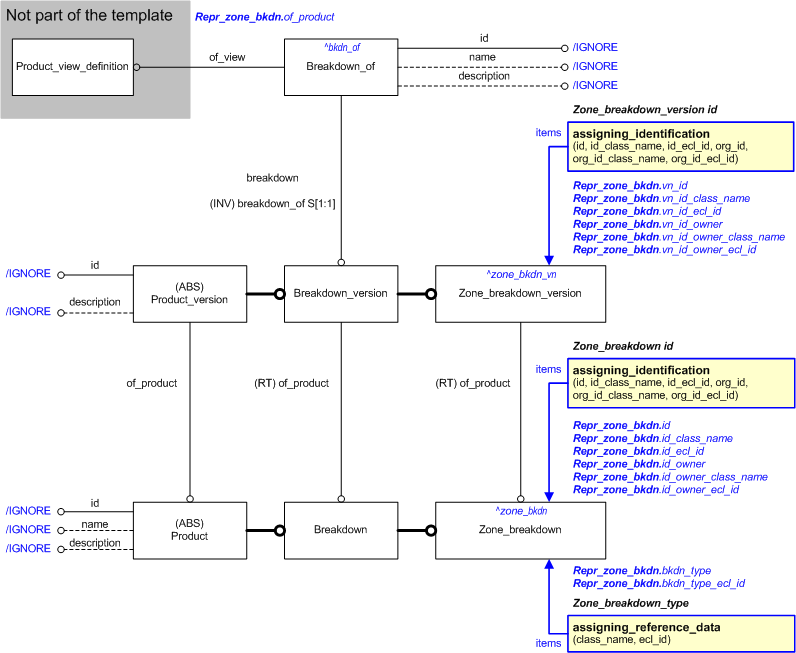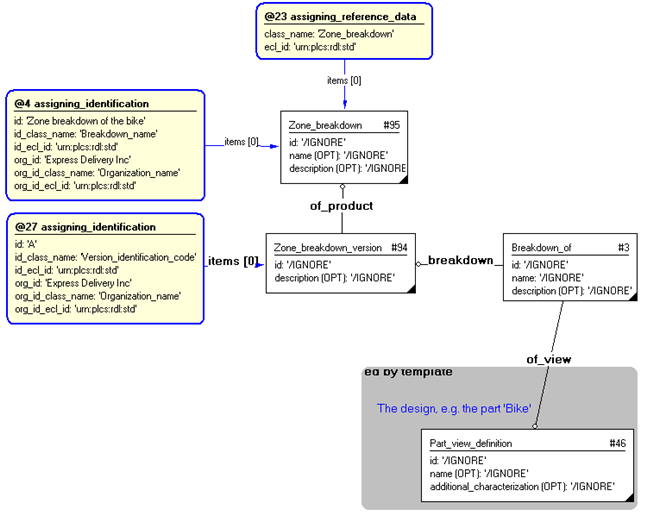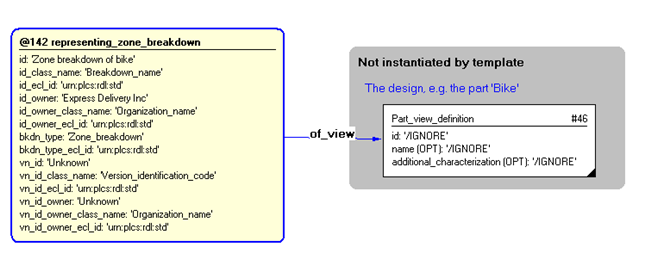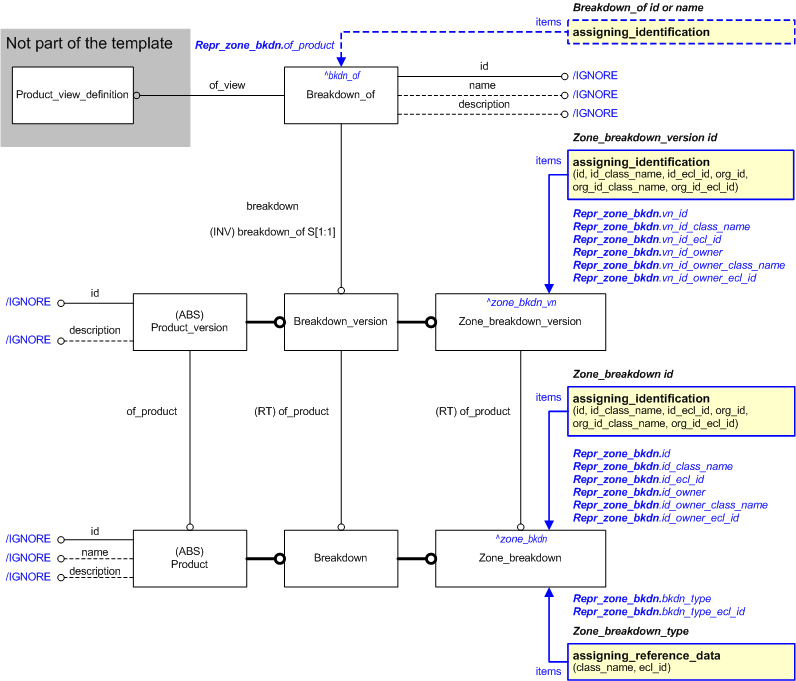| Template:— representing_zone_breakdown (rep_zone_bkdn) |
Date: 2009/04/23 00:30:34
Revision: 1.13
|
This section specifies the template representing_zone_breakdown.
NOTE
An explanation of a template and the associated instantiation path is
provided in the
Template overview
section.
This template describes how to represent zonal decomposition.
The EXPRESS-G diagram in
Figure
1
shows the templates and EXPRESS entities that are required
to represent the template
"representing_zone_breakdown".
The text highlighted in blue shows the template parameters.
Templates within grey areas and templates with dashed outlines are not included in the template, but may be used
to further
characterize the template.
Figure 1 — An EXPRESS-G representation of the Information model for representing_zone_breakdown
The graphic for the template to be used in other EXPRESS-G diagrams
is shown in Figure
2
below.
Templates within grey areas and templates with dashed outlines are not included in the template, but may be used
to further
characterize the template.
Figure 2 — The graphical representation of the representing_zone_breakdown template
The following input parameters are defined for this template:
The identifier of the Zone_breakdown.
The name of the class used to classify the identification
(
Identification_assignment)
of the zone breakdown. This provides the role or reason for the identification.
The following classes and their sub-classes can be used:
id_ecl_id (Default=urn:plcs:rdl:std,Type='URN')
The identifier of the
External_class_library
storing the definition of the class referenced by the parameter @id_class_name class.
The name or identifier of the organization that is responsible for naming or identifying the zonal breakdown.
The name of the class used to classify the
identification of the organization. For example, the organization might be identified using a CAGE code or using
a name.
The following classes and their sub-classes can be used:
The following classes and their sub-classes can be used:
The identifier of the
External_class_library
storing the definition of the class referenced by the parameter @bkdn_type class.
vn_id (Default=Unknown,Type='STRING')
The identifier of the Zone_breakdown_version.
The name of the class used to classify the identification
(
Identification_assignment)
of the zonal breakdown version. This provides the role or reason for the identification.
The following classes and their sub-classes can be used:
The identifier of the
External_class_library
storing the definition of the class referenced by the parameter @vn_id_class_name class.
The name or identifier of the organization responsible for identifying the zonal breakdown version.
The name of the class used to classify the
identification of the organization. For example, the organization might be identified using a CAGE code or using
a name.
The following classes and their sub-classes can be used:
The product that is described in terms of its component zones.
The following reference parameters are defined for this template:
Allow the
Zone_breakdown
entity instantiated in this path to be referenced when this template is used.
Note: The
Zone_breakdown
entity can be referenced in a template path by:
%^target = $representing_zone_breakdown.zone_bkdn%
Allow the
Zone_breakdown_version
entity instantiated in this path to be referenced when this template is used.
%^target = $representing_zone_breakdown.zone_bkdn_vn%
Allow the
Breakdown_of
entity instantiated in this path to be referenced when this template is used.
Note: The
Breakdown_of
entity can be referenced in a template path by:
%^target = $representing_zone_breakdown.bkdn_of%
where
target
is the parameter to which the
Breakdown_of
is bound.
The following parameter combinations specify a uniqueness constraint:
Unique constraint: External id class for Zone_breakdown
Unique constraint: External id class for Zone_breakdown_version
The instantiation path shown below specifies the entities that are to be
instantiated by the template.
A description of templates and the syntax for the instantiation path is
provided in the
Templates Help/Information section.
-- instantiate Zone_breakdown Zone_breakdown%^zone_bkdn =
Zone_breakdown%
Zone_breakdown.id = '/IGNORE'
Zone_breakdown.name = '/IGNORE'
Zone_breakdown.description = '/IGNORE'
-- assign ID to Zone_breakdown /
assigning_identification(
id=@id,
id_class_name=@id_class_name,
id_ecl_id=@id_ecl_id,
org_id=@id_owner,
org_id_class_name=@id_owner_class_name,
org_id_ecl_id=@id_owner_ecl_id,
items=^zone_bkdn)/
-- instantiate Zone_breakdown_version Zone_breakdown_version%^zone_bkdn_vn =
Zone_breakdown_version%
Zone_breakdown_version.id = '/IGNORE'
Zone_breakdown_version.description = '/IGNORE'
Zone_breakdown_version.of_product ->
Zone_breakdown-- assign ID to Zone_breakdown_version /
assigning_identification(
id=@vn_id,
id_class_name=@vn_id_class_name,
id_ecl_id=@vn_id_ecl_id,
org_id=@vn_id_owner,
org_id_class_name=@vn_id_owner_class_name,
org_id_ecl_id=@vn_id_owner_ecl_id,
items=^zone_bkdn_vn)/
-- instantiate Breakdown_of Breakdown_of%^bkdn_of =
Breakdown_of%
Breakdown_of.id = '/IGNORE'
Breakdown_of.name = '/IGNORE'
Breakdown_of.description = '/IGNORE'
Breakdown_of.breakdown ->
Zone_breakdown_versionBreakdown_of.of_view ->
@of_product-- assign type of breakdown to the Zone_breakdown /
assigning_reference_data(
items=Zone_breakdown,
class_name=@bkdn_type,
ecl_id=@bkdn_type_ecl_id)/
The following entities are instantiated with attributes as specified:
The instance diagram in Figure
3
shows an example of the EXPRESS entities and templates that are instantiated by the template:
/representing_zone_breakdown(id='Zone breakdown of the bike', class_name='Breakdown_name', id_ecl_id='urn:plcs:rdl:std', id_owner='Express Delivery Inc', id_owner_class_name='Organization_name', id_owner_ecl_id='urn:plcs:rdl:std', bkdn_type='Zone_breakdown', bkdn_type_ecl_id='urn:plcs:rdl:sample', vn_id='A', vn_class_name='Version_identification_code', vn_id_ecl_id='urn:plcs:rdl:std', vn_id_owner='Express Delivery Inc', vn_id_owner_class_name='Organization_name', vn_id_owner_ecl_id='urn:plcs:rdl:std', of_product='#46')/
(an illustration of the consolidated representing_zone_breakdown template is shown in
Figure
4 below.)
Figure 3 — Entities instantiated by representing_zone_breakdown template
The instance diagram in
Figure
4
shows the graphic symbol for the template that is to be
used in other instance diagrams. The example template is:
/representing_zone_breakdown(id='Zone breakdown of the bike', class_name='Breakdown_name', id_ecl_id='urn:plcs:rdl:std', id_owner='Express Delivery Inc', id_owner_class_name='Organization_name', id_owner_ecl_id='urn:plcs:rdl:std', bkdn_type='Zone_breakdown', bkdn_type_ecl_id='urn:plcs:rdl:sample', vn_id='A', vn_class_name='Version_identification_code', vn_id_ecl_id='urn:plcs:rdl:std', vn_id_owner='Express Delivery Inc', vn_id_owner_class_name='Organization_name', vn_id_owner_ecl_id='urn:plcs:rdl:std', of_product='#46')/
Figure 4 — Instantiation of representing_zone_breakdown template
The following section details how the
representing_zone_breakdown
template can be optionally characterized by assigning
other constructs to it. These are characterizations commonly
applied to the template. The ISO 10303-239 EXPRESS model may enable
other assignments to the entities instantiated by the template.
The EXPRESS-G diagram in Figure
5
shows the possible characterizations of the template
"representing_zone_breakdown".
Figure 5 — Characterizations for representing_zone_breakdown template
The following characterizations may apply:
Characterization General
NOTE this characterization is optional.
Any Breakdown
may be characterized in several ways. None of those are specific to Breakdowns, and therefore
not discussed in detail here.
The following are a few examples of such general characterizations.
Zone_breakdowns
and Zone_breakdown_versions
can be characterized by:
-
Activities and Activity_methods (including Task_method and Scheme).
-
States, e.g. for life cycle status assignments.
-
Date, time and effectivities.
-
Documents.
-
Organizations and persons, e.g. to identify owner or creator.
-
Projects and contract assignments.
-
Requirements.
-
etc.
Characterization Assigning identifications
NOTE this characterization is optional.





